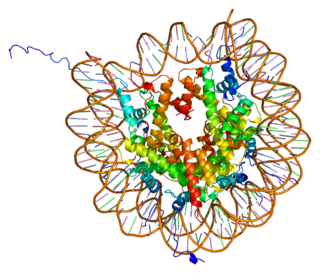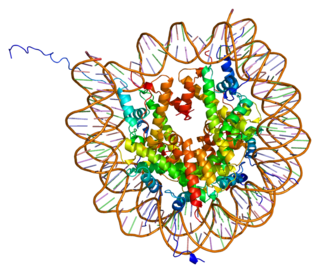Related Research Articles

Histone H4 is one of the five main histone proteins involved in the structure of chromatin in eukaryotic cells. Featuring a main globular domain and a long N-terminal tail, H4 is involved with the structure of the nucleosome of the 'beads on a string' organization. Histone proteins are highly post-translationally modified. Covalently bonded modifications include acetylation and methylation of the N-terminal tails. These modifications may alter expression of genes located on DNA associated with its parent histone octamer. Histone H4 is an important protein in the structure and function of chromatin, where its sequence variants and variable modification states are thought to play a role in the dynamic and long term regulation of genes.
Histone H2B is one of the 5 main histone proteins involved in the structure of chromatin in eukaryotic cells. Featuring a main globular domain and long N-terminal and C-terminal tails, H2B is involved with the structure of the nucleosomes.

Methyltransferases are a large group of enzymes that all methylate their substrates but can be split into several subclasses based on their structural features. The most common class of methyltransferases is class I, all of which contain a Rossmann fold for binding S-Adenosyl methionine (SAM). Class II methyltransferases contain a SET domain, which are exemplified by SET domain histone methyltransferases, and class III methyltransferases, which are membrane associated. Methyltransferases can also be grouped as different types utilizing different substrates in methyl transfer reactions. These types include protein methyltransferases, DNA/RNA methyltransferases, natural product methyltransferases, and non-SAM dependent methyltransferases. SAM is the classical methyl donor for methyltransferases, however, examples of other methyl donors are seen in nature. The general mechanism for methyl transfer is a SN2-like nucleophilic attack where the methionine sulfur serves as the leaving group and the methyl group attached to it acts as the electrophile that transfers the methyl group to the enzyme substrate. SAM is converted to S-Adenosyl homocysteine (SAH) during this process. The breaking of the SAM-methyl bond and the formation of the substrate-methyl bond happen nearly simultaneously. These enzymatic reactions are found in many pathways and are implicated in genetic diseases, cancer, and metabolic diseases. Another type of methyl transfer is the radical S-Adenosyl methionine (SAM) which is the methylation of unactivated carbon atoms in primary metabolites, proteins, lipids, and RNA.
Propionyl-CoA is a coenzyme A derivative of propionic acid. It is composed of a 24 total carbon chain and its production and metabolic fate depend on which organism it is present in. Several different pathways can lead to its production, such as through the catabolism of specific amino acids or the oxidation of odd-chain fatty acids. It later can be broken down by propionyl-CoA carboxylase or through the methylcitrate cycle. In different organisms, however, propionyl-CoA can be sequestered into controlled regions, to alleviate its potential toxicity through accumulation. Genetic deficiencies regarding the production and breakdown of propionyl-CoA also have great clinical and human significance.
Demethylases are enzymes that remove methyl (CH3) groups from nucleic acids, proteins (particularly histones), and other molecules. Demethylases are important epigenetic proteins, as they are responsible for transcriptional regulation of the genome by controlling the methylation of DNA and histones, and by extension, the chromatin state at specific gene loci.

Histone-modifying enzymes are enzymes involved in the modification of histone substrates after protein translation and affect cellular processes including gene expression. To safely store the eukaryotic genome, DNA is wrapped around four core histone proteins, which then join to form nucleosomes. These nucleosomes further fold together into highly condensed chromatin, which renders the organism's genetic material far less accessible to the factors required for gene transcription, DNA replication, recombination and repair. Subsequently, eukaryotic organisms have developed intricate mechanisms to overcome this repressive barrier imposed by the chromatin through histone modification, a type of post-translational modification which typically involves covalently attaching certain groups to histone residues. Once added to the histone, these groups elicit either a loose and open histone conformation, euchromatin, or a tight and closed histone conformation, heterochromatin. Euchromatin marks active transcription and gene expression, as the light packing of histones in this way allows entry for proteins involved in the transcription process. As such, the tightly packed heterochromatin marks the absence of current gene expression.

Histone H2B type 3-B is a protein that in humans is encoded by the HIST3H2BB gene.

Metastasis-associated protein MTA2 is a protein that in humans is encoded by the MTA2 gene.

Histone H2B type 1-L is a protein that in humans is encoded by the HIST1H2BL gene.

Histone H2B type 1-O is a protein that in humans is encoded by the HIST1H2BO gene.

Histone H2B type F-S is a protein that in humans is encoded by the H2BC12L gene. It's a histone H2B isoform.

Histone H2B type 1-H is a protein that in humans is encoded by the HIST1H2BH gene.

Histone H2B type 1-C/E/F/G/I is a protein that in humans is encoded by the HIST1H2BE gene.
The Human Proteome Project (HPP) is a collaborative effort coordinated by the Human Proteome Organization. Its stated goal is to experimentally observe all of the proteins produced by the sequences translated from the human genome.
Succinylation is a posttranslational modification where a succinyl group (-CO-CH2-CH2-CO2H) is added to a lysine residue of a protein molecule. This modification is found in many proteins, including histones. The potential role of succinylation is under investigation, but as addition of succinyl group changes lysine's charge from +1 to −1 (at physiological pH) and introduces a relatively large structural moiety (100 Da), bigger than acetylation (42 Da) or methylation (14 Da), it is expected to lead to more significant changes in protein structure and function.
H3K27ac is an epigenetic modification to the DNA packaging protein histone H3. It is a mark that indicates acetylation of the lysine residue at N-terminal position 27 of the histone H3 protein.
H4K16ac is an epigenetic modification to the DNA packaging protein Histone H4. It is a mark that indicates the acetylation at the 16th lysine residue of the histone H4 protein.
H4K5ac is an epigenetic modification to the DNA packaging protein histone H4. It is a mark that indicates the acetylation at the 5th lysine residue of the histone H4 protein. H4K5 is the closest lysine residue to the N-terminal tail of histone H4. It is enriched at the transcription start site (TSS) and along gene bodies. Acetylation of histone H4K5 and H4K12ac is enriched at centromeres.
H4K8ac, representing an epigenetic modification to the DNA packaging protein histone H4, is a mark indicating the acetylation at the 8th lysine residue of the histone H4 protein. It has been implicated in the prevalence of malaria.
H3K56ac is an epigenetic modification to the DNA packaging protein Histone H3. It is a mark that indicates the acetylation at the 56th lysine residue of the histone H3 protein.
References
- ↑ Shui, Ke; Wang, Chenwei; Zhang, Xuedi; Ma, Shanshan; Li, Qinyu; Ning, Wanshan; Zhang, Weizhi; Chen, Miaomiao; Peng, Di; Hu, Hui; Fang, Zheng; Guo, Anyuan; Gao, Guanjun; Ye, Mingliang; Zhang, Luoying (2023-05-17). "Small-sample learning reveals propionylation in determining global protein homeostasis". Nature Communications. 14 (1): 2813. Bibcode:2023NatCo..14.2813S. doi: 10.1038/s41467-023-38414-8 . ISSN 2041-1723. PMC 10192394 . PMID 37198164.
- ↑ Chen, Y; Sprung, R; Tang, Y; Ball, H; Sangras, B; Kim, SC; Falck, JR; Peng, J; Gu, W; Zhao, Y (May 2007). "Lysine propionylation and butyrylation are novel post-translational modifications in histones". Molecular & Cellular Proteomics. 6 (5): 812–9. doi: 10.1074/mcp.M700021-MCP200 . PMC 2911958 . PMID 17267393.
- ↑ Cheng, Z; Tang, Y; Chen, Y; Kim, S; Liu, H; Li, SS; Gu, W; Zhao, Y (January 2009). "Molecular characterization of propionyllysines in non-histone proteins". Molecular & Cellular Proteomics. 8 (1): 45–52. doi: 10.1074/mcp.M800224-MCP200 . PMC 2621001 . PMID 18753126.
- ↑ Kebede, Adam F.; Nieborak, Anna; Shahidian, Lara Zorro; Le Gras, Stephanie; Richter, Florian; Gómez, Diana Aguilar; Baltissen, Marijke P.; Meszaros, Gergo; Magliarelli, Helena de Fatima; Taudt, Aaron; Margueron, Raphael (December 2017). "Histone propionylation is a mark of active chromatin". Nature Structural & Molecular Biology. 24 (12): 1048–1056. doi:10.1038/nsmb.3490. hdl: 2066/207705 . ISSN 1545-9985. PMID 29058708. S2CID 9788234.
- 1 2 Lagerwaard, Bart; Pougovkina, Olga; Bekebrede, Anna F.; Brinke, Heleen; Wanders, Ronald J.A.; Nieuwenhuizen, Arie G.; Keijer, Jaap; Boer, Vincent C. J. (2020-08-17). "Increased protein propionylation contributes to mitochondrial dysfunction in liver cells and fibroblasts, but not in myotubes". Journal of Inherited Metabolic Disease. 44 (2): 438–449. doi: 10.1002/jimd.12296 . ISSN 0141-8955. PMC 8049071 . PMID 32740932.
- ↑ Pougovkina, Olga; Te Brinke, Heleen; Wanders, Ronald J. A.; Houten, Sander M.; de Boer, Vincent C. J. (September 2014). "Aberrant protein acylation is a common observation in inborn errors of acyl-CoA metabolism". Journal of Inherited Metabolic Disease. 37 (5): 709–714. doi: 10.1007/s10545-014-9684-9 . ISSN 1573-2665. PMID 24531926. S2CID 26627794.